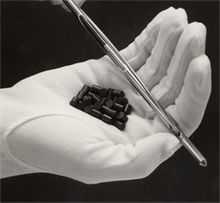Nuclear engineering
Nuclear engineering is the branch of engineering concerned with the application of the breakdown (fission) as well as the fusion of atomic nuclei and/or the application of other sub-atomic physics, based on the principles of nuclear physics. In the sub-field of nuclear fission, it particularly includes the interaction and maintenance of systems and components like nuclear reactors, nuclear power plants, and/or nuclear weapons. The field also includes the study of medical and other applications of (generally ionizing) radiation, nuclear safety, heat/thermodynamics transport, nuclear fuel and/or other related technology (e.g., radioactive waste disposal), and the problems of nuclear proliferation.[1]
Professional areas
Smaller elements and other particles including neutrons.
The United States gets about 18 % of its electricity from nuclear power plants.[2] Nuclear engineers in this field generally work, directly or indirectly, in the nuclear power industry or for national laboratories. Current research in the industry is directed at producing economical, proliferation-resistant reactor designs with passive safety features. Although government labs research the same areas as industry, they also study a myriad of other issues such as nuclear fuels and nuclear fuel cycles, advanced reactor designs, and nuclear weapon design and maintenance. A principal pipeline for trained personnel for US reactor facilities is the Navy Nuclear Power Program.
-

Nuclear powerplant
-
.jpg)
B-61 thermonuclear weapon
Nuclear medicine and medical physics
An important field is medical physics, and its subfields nuclear medicine, radiation therapy, health physics, and diagnostic imaging.[3] From x-ray machines to MRI to PET, among many others, medical physics provides most of modern medicine's diagnostic capability along with providing many treatment options.-

X-Ray Image of a male skull
-

Magnetic Resonance Imaging scan of a head
-

PET taken with an ECAT Exact HR+ PET Scanner
Nuclear materials and nuclear fuels
Nuclear materials research focuses on two main subject areas, nuclear fuels and irradiation-induced modification of materials. Improvement of three nuclear fuels is crucial for obtaining increased efficiency from nuclear reactors. Irradiation effects studies have many purposes, from studying structural changes to reactor components to studying nano-modification of metals using ion-beams or particle accelerators.
-

Uranium ore, the principal raw material of nuclear fuel
-

Nuclear fuel pellets
Radiation protection and measurement
Radiation measurement is fundamental to the science and practice of radiation protection, sometimes known as radiological protection, which is the protection of people and the environment from the harmful effects of ionizing radiation
Nuclear engineers and radiological scientists are interested in the development of more advanced ionizing radiation measurement and detection systems, and using these to improve imaging technologies. This includes detector design, fabrication and analysis, measurements of fundamental atomic and nuclear parameters, and radiation imaging systems, among other things.
-

A modern Geiger counter
-

Scintillation detector next to uraninite
-

Hand-held large area alpha scintillation probe under calibration
-

Hand-held integral ion chamber survey meter in use
Nuclear engineering organizations
See also
|
|
References
- ↑ Journal of Petroleum Engineering and Technology"Journal of Petroleum Engineering and Technology". JoPET. Retrieved 2011-03-20.
- ↑ http://www.eia.doe.gov/cneaf/electricity/epm/tablees1a.html
- ↑ http://www.aapm.org/medical_physicist/fields.asp
Further reading
- Gowing, Margaret. Britain and Atomic Energy, 1939–1945 (1964).
- Gowing, Margaret, and Lorna Arnold. Independence and Deterrence: Britain and Atomic Energy, Vol. I: Policy Making, 1945–52; Vol. II: Policy Execution, 1945–52 (London, 1974)
- Johnston, Sean F. "Creating a Canadian Profession: The Nuclear Engineer, 1940–68," Canadian Journal of History, Winter 2009, Vol. 44 Issue 3, pp 435–466
- Johnston, Sean F. "Implanting a discipline: the academic trajectory of nuclear engineering in the USA and UK," Minerva, 47 (2009), pp. 51–73
External links
| The Wikibook Wikiversity has a page on the topic of: Nuclear Engineering |
- Science and Technology of Nuclear Installation Open-Access Journal
- Nuclear Engineering International magazine
- Nuclear Science and Engineering technical journal
- Electric Generation from Commercial Nuclear Power
- Hacettepe University Department of Nuclear Engineering
| ||||||||||||||||||||||||||
| ||||||||||||||||||||||||||||||||||||||||||||||||||||||||||||||||||||||||||||||||||||||||||||||||||||||||||||||
| |||||||||||||||||||||||||||||||||||||||||||||||||||||||||||||

